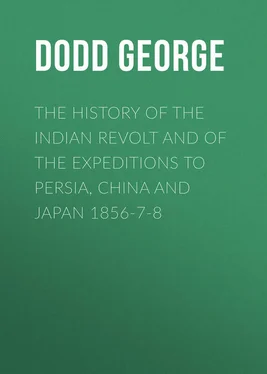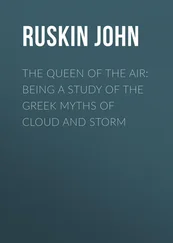George Dodd - The History of the Indian Revolt and of the Expeditions to Persia, China and Japan 1856-7-8
Здесь есть возможность читать онлайн «George Dodd - The History of the Indian Revolt and of the Expeditions to Persia, China and Japan 1856-7-8» — ознакомительный отрывок электронной книги совершенно бесплатно, а после прочтения отрывка купить полную версию. В некоторых случаях можно слушать аудио, скачать через торрент в формате fb2 и присутствует краткое содержание. Жанр: foreign_antique, foreign_prose, на английском языке. Описание произведения, (предисловие) а так же отзывы посетителей доступны на портале библиотеки ЛибКат.
- Название:The History of the Indian Revolt and of the Expeditions to Persia, China and Japan 1856-7-8
- Автор:
- Жанр:
- Год:неизвестен
- ISBN:нет данных
- Рейтинг книги:3 / 5. Голосов: 1
-
Избранное:Добавить в избранное
- Отзывы:
-
Ваша оценка:
- 60
- 1
- 2
- 3
- 4
- 5
The History of the Indian Revolt and of the Expeditions to Persia, China and Japan 1856-7-8: краткое содержание, описание и аннотация
Предлагаем к чтению аннотацию, описание, краткое содержание или предисловие (зависит от того, что написал сам автор книги «The History of the Indian Revolt and of the Expeditions to Persia, China and Japan 1856-7-8»). Если вы не нашли необходимую информацию о книге — напишите в комментариях, мы постараемся отыскать её.
The History of the Indian Revolt and of the Expeditions to Persia, China and Japan 1856-7-8 — читать онлайн ознакомительный отрывок
Ниже представлен текст книги, разбитый по страницам. Система сохранения места последней прочитанной страницы, позволяет с удобством читать онлайн бесплатно книгу «The History of the Indian Revolt and of the Expeditions to Persia, China and Japan 1856-7-8», без необходимости каждый раз заново искать на чём Вы остановились. Поставьте закладку, и сможете в любой момент перейти на страницу, на которой закончили чтение.
Интервал:
Закладка:
This interesting train of adventures we have followed to its close, as illustrating so many points connected with the state of India at the time; but now attention must be brought back to the month of May.
West of the Rohilcund district, and northwest of Allygurh and its neighbouring cluster of towns, lie Meerut and Delhi, the two places at which the atrocities were first manifested. Meerut, after the departure of the three mutinous regiments on the night of the 10th of May, and the revolt of the Sappers and Miners a few days afterwards, remained unmolested. Major-general Hewett was too strong in European troops to be attacked, although his force took part in many operations against the rebels elsewhere. Several prisoners, proved to have been engaged in the murderous work of the 10th, were hanged. On the other hand, many sowars of the 3d native cavalry, instead of going to Delhi, spread terror among the villagers near Meerut. One of the last military dispatches of the commander-in-chief was to Hewett, announcing his intention to send most of his available troops from Kurnaul by Bhagput and Paniput, to Delhi, and requesting Hewett to despatch from Meerut an auxiliary force. This force he directed should consist of two squadrons of carabiniers, a wing of the 60th Rifles, a light field-battery, a troop of horse-artillery, a corps of artillerymen to work the siege-train, and as many sappers as he could depend upon. General Anson calculated that if he left Umballa on the 1st of June, and if Hewett sent his force from Meerut on the 2d, they might meet at Bhagput on the 5th, when a united advance might be made upon Delhi; but, as we shall presently see, the hand of death struck down the commander-in-chief ere this plan could be carried out; and the force from Meerut was placed at the disposal of another commander, under circumstances that will come under notice in their proper place.
Delhi, like Cawnpore, must be treated apart from other towns. The military proceedings connected with its recapture were so interesting, and carried on over so long a period; it developed resources so startlingly large among the mutineers, besieging forces so lamentably small on the part of the British – that the whole will conveniently form a subject complete in itself, to be treated when collateral events have been brought up to the proper level. Suffice it at present to say, that the mutineers over the whole of the north of India looked to the retention of Delhi as their great stronghold, their rock of defence; while the British saw with equal clearness that the recapture of that celebrated city was an indispensable preliminary to the restoration of their prestige and power in India. All the mutineers from other towns either hastened to Delhi, or calculated on its support to their cause, whatever that cause may have been; all the available British regiments, on the other hand, few indeed as they were, either hastened to Delhi, or bore it in memory during their other plans and proceedings.
Just at the time when the services of a military commander were most needed in the regions of which Agra is the centre, and when it was necessary to be in constant communication with the governor-general and authorities, General Anson could not be heard of; he was supposed at Calcutta to be somewhere between Simla and Delhi; but dâks and telegraphs had been interfered with, and all remained in mystery as to his movements. Lawrence at Lucknow, Ponsonby at Benares, Wheeler at Cawnpore, Colvin at Agra, Hewett at Meerut, other commanders at Allahabad, Dinapoor, and elsewhere – all said in effect: ‘We can hold our own for a time, but not unless Delhi be speedily recaptured. Where is the commander-in-chief?’ Viscount Canning sent messages in rapid succession, during the second half of the month of May, entreating General Anson to bring all his power to bear on Delhi as quickly as possible. Duplicate telegrams were sent by different routes, in hopes that one at least might reach its destination safely; and every telegram told the same story – that British India was in peril so long as Delhi was not in British hands, safe from murderers and marauders. Major-general Sir Henry Barnard, military commander of the Umballa district, received telegraphic news on the 11th of May of the outrages at Meerut and Delhi; and immediately sent an aid-de-camp to gallop off with the information to General Anson at Simla, seventy or eighty miles distant. The commander-in-chief at once hastened from his retirement among the hills. Simla, as was noticed in a former page, is one of the sanataria for the English in India, spots where pure air and moderate temperature restore to the jaded body some of the strength, and to the equally jaded spirits some of the elasticity, which are so readily lost in the burning plains further south. The poorer class among the Europeans cannot afford the indulgence, for the cost is too great; but the principal servants of the Company often take advantage of this health-restoring and invigorating climate – where the average temperature of the year is not above 55° F. The question has been frequently discussed, and is not without cogency, whether the commander-in-chief acted rightly in remaining at that remote spot during the first twenty weeks in the year, when so many suspicious symptoms were observable among the native troops at Calcutta, Dumdum, Barrackpore, Berhampore, Lucknow, Meerut, and Umballa. He could know nothing of the occurrences at those places but what the telegraphic wires and the postal dâks told him; nevertheless, if they told him the truth, and all the truth, it seems difficult to understand, unless illness paralysed his efforts, why he, the chief of the army, remained quiescent at a spot more than a thousand miles from Calcutta.
Startled by the news, the commander-in-chief quitted Simla, and hastened to Umballa, the nearest military station on the great Indian highway. It then became sensibly felt, both by Anson and Barnard, how insufficient were the appliances at their disposal. The magazines at Umballa were nearly empty of stores and ammunition; the reserve artillery-wagons were at Phillour, eighty miles away; the native infantry were in a very disaffected state; the European troops were at various distances from Umballa; the commissariat officers declared it to be almost impossible to move any body of troops, in the absence of necessary supplies for a column in the field; and the medical officers dwelt on the danger of marching troops in the hot season, and on the want of conveyance for sick and wounded. In short, almost everything was wanting, necessary for the operations of an army. The generals set to work, however; they ordered the 2d European Fusiliers to hasten from Subathoo to Umballa; the Nusseree Battalion to escort a siege-train and ammunition from Phillour to Umballa; six companies of the Sappers and Miners to proceed from Roorkee to Meerut; and the 4th Irregular Cavalry to hold themselves in readiness at Hansi. Anson at the same time issued the general order, already adverted to, inviting the native regiments to remain true to their allegiance, explaining the real facts concerning the cartridges, and reiterating the assurances of non-intervention with the religious and caste scruples of the men. On the 17th there were more than seven regiments of troops at Umballa – namely, the Queen’s 9th Lancers, the 4th Light Cavalry Lancers, the Queen’s 75th foot, the 1st and 2d European Fusiliers, the 5th and 60th native infantry, and two troops of European horse-artillery; but the European regiments were all far short of their full strength. Symptoms soon appeared that the 5th and 60th native infantry were not to be relied upon for fidelity; and General Anson thereupon strengthened his force at Umballa with such European regiments as were obtainable. He was nevertheless in great perplexity how to shape his course; for so many wires had been cut and so many dâks stopped, that he knew little of the progress of events around Delhi and Agra. Being new to India and Indian warfare, also, and having received his appointment to that high command rather through political connections than in reference to any experience derived from Asiatic campaigning, he was dependent on those around him for suggestions concerning the best mode of grappling with the difficulties that were presented. These suggestions, in all probability, were not quite harmonious; for it has long been known that, in circumstances of emergency, the civil and military officers of the Company, viewing occurrences under different aspects or from different points of view, often arrived at different estimates as to the malady to be remedied, and at different suggestions as to the remedy to be applied. At the critical time in question, however, all the officers, civil as well as military, assented to the conclusion that Delhi must be taken at any cost; and on the 21st of May, the first division of a small but well-composed force set out from Umballa on the road to Delhi. General Anson left on the 25th, and arrived on the 26th at Kurnaul, to be nearer the scene of active operations; but there death carried him off. He died of cholera on the next day, the 27th of May.
Читать дальшеИнтервал:
Закладка:
Похожие книги на «The History of the Indian Revolt and of the Expeditions to Persia, China and Japan 1856-7-8»
Представляем Вашему вниманию похожие книги на «The History of the Indian Revolt and of the Expeditions to Persia, China and Japan 1856-7-8» списком для выбора. Мы отобрали схожую по названию и смыслу литературу в надежде предоставить читателям больше вариантов отыскать новые, интересные, ещё непрочитанные произведения.
Обсуждение, отзывы о книге «The History of the Indian Revolt and of the Expeditions to Persia, China and Japan 1856-7-8» и просто собственные мнения читателей. Оставьте ваши комментарии, напишите, что Вы думаете о произведении, его смысле или главных героях. Укажите что конкретно понравилось, а что нет, и почему Вы так считаете.












